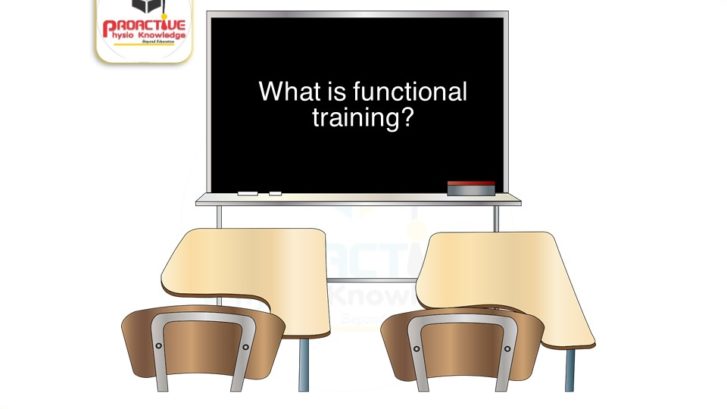What is Functional training
“Power is nothing without control”
The basic goal in rehabilitation is to restore and enhance function within the environment and to perform specific activities of daily living (ADL). The entire rehabilitation process should be focused on improving the functional status of the patient. The concept of functional training is not new, nor is it limited to function related to sports. By definition, function means having a purpose or duty. Therefore, functional can be defined as performing a practical or intended function or duty.
It is widely accepted that to perform a specific activity better, one must practice that activity. Therefore, the functional exercise progression for return to ADL can best be defined as breaking the specific activities down into a hierarchy and then performing them in a sequence that allows acquisition or reacquisition of that skill.
The brain thinks in terms of movement pattern, not individual muscles. If the goal is to enhance endurance and power in sport, then training should be in the direction of its requirement task. The muscles should be strengthen to its maximum threshold. It is also commonly thought that strength training works best when movement occurs in only one plane and is limited to a single joint.
However, functional training integrates many muscle groups. It is by placing the body in the less stable surface but more functional position task. We often including the performance of multi joint exercises. If the goal is to improve movement patterns that are used in daily activity then multi joint training exercise should incorporates into multi planer stability.
“Functional training is that which makes a person more functional”. It is not possible to activate single muscles to 100% of their maximal voluntary contraction in functional exercises “because this would upset the balance of moments in all cardinal plane. Mcgill States that Muscle activation levels are quite modest even though the tasks are fairly strenuous. Additionally author states that constraints are one aspect of what separates ‘functional’ exercises from muscle isolationist exercises, in which machines create constraints to allow single muscles to activate to very high levels.
It is often taught that to build power strength training of 80% to 95%, one or three to five repetition maximums (RMs) are required. Sotiropoulous et al. demonstrated that half squats performed as a dynamic warm-up at low to moderate intensity, but maximum velocity improved countermovement jump performance significantly. According to Siff and Verkhoshansky exercises with submaximal loads prepare the nervous systems for explosive activities.
The kettlebell use is also a novel way to introduce more functional training. Lake and Lauder recently reported that the kettlebell swing was as effective for improving maximal strength and explosive strength. Specifically frontal plane plyometric power has been shown to correlate with throwing velocity in collegiate baseball players . likewise, demonstration of power in an overhead medicine ball toss which had a strong direct relationship with throwing velocity in collegiate baseball and softball players .
Each exercise can be made very strenuous, although initially they should involve controlled resistance only so that the agility, balance, and coordination can be programmed.
When center of mass is dynamically maintained over the body’s base, equilibrium is maximized. When key joints are functionally centrated, agonist–antagonist muscles’ length–tension relationships are optimized for stability and power.
Take home message :
Frontal plane task performance automatically creates stability demand on the individual.
References:
- McGill SM, Karpowicz A, Fenwick CMJ, Brown SHM. Exercises for the torso performed in a standing posture: spine and hip motion and motor patterns and spine load. J Strength Cond Res 2009;23(2):455–464.
- Clark RA, Bryant AL, Reaburn P. The acute effects of a single set of contrast preloading on a loaded countermovement jump training session. J Strength Cond Res 2006;20:162–166.
- Comyns TM, Harrison AJ, Hennesey LK, Jensen R. The optimal complex training rest interval for athletes from anaerobic sports. J Strength Cond Res 2006;20:471–476.
- Deutsch M, Lloyd R. Effect of order of exercise on performance during a complex training session in rugby players. J Sports Sci 2008;26(8):803–809.
- Kilduff LP, Bevan HR, Kingsley MIC, et al. Postactivation potentiation in professional rugby players: optimal recovery. J Strength Cond Res 2007;21:1134–1138.
- Weber KR, Brown LE, Coburn JW, Zinder SM. Acute effects of heavy-load squats on consecutive squat jump performance. J Strength Cond Res 2008;22(3):726–730
- Sotiropoulous K, Smilios I, Christou M, et al. Effect of warm-up on vertical jump performance and muscle electrical activity using half-squats at low and moderate intensity. J Sports Sci Med 2012;9:326–331.
- Siff MC, Verkhoshansky YV. Supertraining: A Textbook on the Biomechanics and Physiology of Strength Conditioning for all Sport. Pittsburgh, PA: Sports Support Syndicate; 1996.
- Lake JP, Lauder MA. Kettlebell swing training improves maximal and explosive strength. J Strength Cond Res 2012;26(8):2228–2233.
- Lehman G, Drinkwater EJ, Behm DG. Correlations of throwing velocity to the results of lower body field tests in male college baseball players. J Strength Cond Res 2013;27(4):902–908.
- Green CM. The Relationship between Core Stability and Throwing Velocity in Collegiate Baseball and Softball Players. Thesis; 2005. 60. Travell JG. Basic Principles of Myofascial Pain. November 1, 1984. (Presented at the Palm Springs Seminars, Inc., November 2–6, 1984 and to the DC Dental Society, April 16, 1985).




hey,
I read your blog post, It was really content.
making my mind clear.